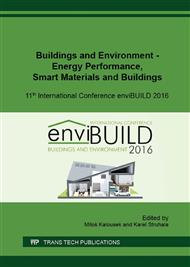p.493
p.501
p.509
p.519
p.527
p.537
p.547
p.556
p.564
Improving the Impact Sound Insulation of an Existing and Refurbished Wooden Beam Floor Construction
Abstract:
A common source of dissatisfaction in buildings pertains to acoustical issues. Specifically, in existing buildings, exposure to impact noise represents a frequent problem. In Central Europe generally, and in Vienna (Austria) specifically, there is a significant number of existing buildings with floor constructions involving wooden beams as structural elements. Given the steady rise in inhabitants' expectations regarding buildings' acoustical quality, such existing floor constructions do not sufficiently provide the sufficient impact noise insulation. In many instances, the replacement of these floor constructions with concrete slabs is not an option, given a number of structural, financial, and legal (conservation related) obstacles and constraints. The present contribution thus explores the acoustical improvement potential of floor constructions with wooden beams by using modern materials and techniques. Toward this end, a typical 19th century building in Vienna downtown was selected. Multiple improvement options were realized. These involved the deployment of a honey-comb acoustic system, installation of stiffeners bolted to the original wooden beams, as well as an additional structurally decoupled ceiling layer. The impact sound was measured at different stages of retrofit and compared with the performance of the original construction.
Info:
Periodical:
Pages:
527-536
Citation:
Online since:
December 2016
Price:
Сopyright:
© 2017 Trans Tech Publications Ltd. All Rights Reserved
Share:
Citation:


